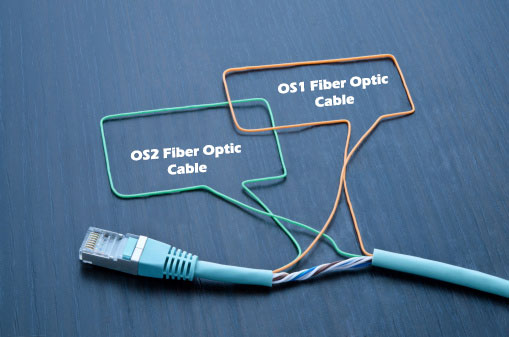March 24, 2016
These are two standards for single mode fibre optic cabling that are generally used today, OS1 and OS2. OS1 and OS2 are cabled single mode optical fibre specifications. The difference between OS1 and OS2 fiber optic cables mainly lie in the performance due to cable construction. How are OS1 and OS2 single mode fiber cables constructed? Choosing the right fiber jumper is very critical to improve the functionality of your network. Here is some information related to the differences between the OS1 and OS2 single mode fiber cables.

OS1 single mode fibers are compliant with ITU-T G.652A/B, and the low-water-peak fibers defined by ITU-T G.652C and G.652D also come under OS1 single mode fibers, that is to say OS1 is compliant with specifications of ITU-T G.652. OS1 cabling is tight-buffered construction, embedded in a heavy polymer jacket. The jacketed fiber is generally enclosed, with a bundle of flexible fibrous polymer strength members like aramid in a lightweight plastic cover to form a simple cable.
OS2 single mode fibers are only compliant with ITU-T G.652C/D standards, which means that OS2 fibers are very clearly the low-water-peak fibers only. OS1 was first introduced in the year 2002 and OS2 in the year 2006. OS2 cabling is loose-tube design. Cable with this construction is appropriate for outdoor cases. For use in more strenuous environments, a much more robust cable construction is required. In loose-tube construction, the fiber is laid helically into semi-rigid tubes, allowing the cable to stretch without stretching the fiber itself. This protects the fiber from tension during laying and due to temperature changes.
For their different cable constructions, OS1 and OS2 fiber cables have different application areas. OS1 is for indoor use, such as campusand data centre. Cabling is is tight buffered (manufactured into solid medium). Indoor fiber is more tolerant of bending. The fiber is more plastic and able to bend plus the buffered cable reduces the risk of catastrophic damage. OS2 is for outdoor or loose tube use, like street, underground/burial, etc. Outdoor fibers are bend sensitive and thus more likely to break during install unless care is taken.
Besides, they also have different degrees of attenuation. OS1 indoor fiber has greater loss per kilometer than OS2. In general, the maximum attenuation for OS1 is 1.0 db/km and 0.4db/km for OS2. As a result, the maximum transmission distance of OS1 single mode fiber is 2 km but the maximum transmission distance of OS2 single mode fiber can reach 5 km and up to 10 km. Though the maximum transmission distance of OS2 single mode fiber is much longer than that of OS1, OS1 is much cheaper than OS2 for the cheaper materials.
But both OS1 and OS2 cable types allow a distance of one to 10 gigabit Ethernet. And another point which needs to be paid attention to is that OS2 single mode optical fiber cables can not be connected with OS1 single mode optical fiber cables because it may lead to unpredictable signal performance. Fiberstore supplies both OS1 and OS2 single mode patch cables, and all other kinds of fiber patch cords with differernt connector options, such as SC single mode patch cable, LC multi-mode patch cable, MPO cable, etc. We provide fiber-based patch cables with high quality.
Posted by: jowang at
02:20 AM
| No Comments
| Add Comment
Post contains 557 words, total size 5 kb.
35 queries taking 0.0176 seconds, 70 records returned.
Powered by Minx 1.1.6c-pink.









